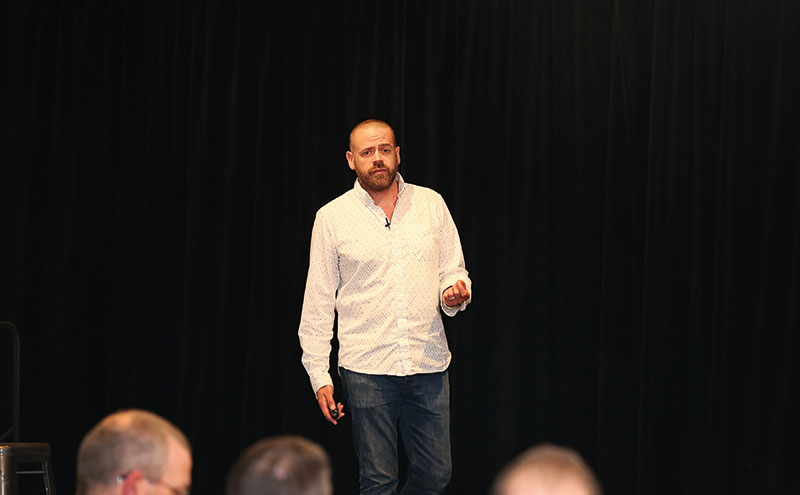
AN Edinburgh-based organisation is using behavioural science insights to help construction firms improve their business performance and create safer, happier workplaces.
Sodak was founded by Bob Cummins, who spent most of his adult life working in construction after graduating as a civil engineer.
Growing disillusioned with the direction health and safety was heading in the sector, he encountered a company using behavioural science to make dramatic improvements and began to study the subject in more detail.
He has now gone on to establish his own successful business and has worked with a number of leading construction firms in the UK, using behavioural insights to make lasting changes to the way organisations – and the individuals within those firms – operate.
Bob explained, “I’d been in construction ever since I left school. I studied as a civil engineer and went into site engineering.
“An advert came out with the company I worked for at the time for a health and safety management position. I applied for the role; I didn’t actually get the job, but I did get offered a secondment to the safety department.
“It was great because you got to see everybody from the directors to the workers.”
From there, Bob progressed up the health and safety ladder and landed roles including head of health and safety at Scottish Water Solutions and, latterly, on the Edinburgh Trams project.
After growing frustrated at certain aspects of health and safety within the construction sector – including an increasing amount of paperwork and a ‘tick-box mentality’ – Bob set out to promote a better way of doing things.
“I met this chap who was teaching behavioural science,” he explained. “Behavioural science is an actual science; an offshoot of psychology. It specialises in human and animal behaviour.
“It’s all about measurement and data; It’s totally objective rather than being subjective.
“Once you understand that a behaviour is measurable, you can start to measure all sorts of behaviours as actions.
“Being a past engineer, this was really quite inviting as engineering is all about measurement.
“I decided to set up my own business to use behavioural science to sort out health and safety.
“The first business I started was called Alternative Safety Limited. Realising that it wasn’t just health and safety that we could sort out, I set up another company called Sodak. In America it’s short for South Dakota, which is where my wife is from.”
Sodak was founded in 2013. Since then, Bob says he’s been “trying to get some realism” back into both health and safety and general business practices, predominantly within construction where most of his contacts are from.
“What we’re trying to do is show the people we touch and interact with that it doesn’t have to be this way,” he added.
“We can actually design something that’s better. We don’t have to put this mask on when we come to work; we can actually treat people with respect, we can treat those delivering our jobs for us with respect.
“Construction has historically been quite coercive in the past, especially towards the worker and the labourer.
“There’s a lot of blame directed towards those guys. If we can remove ourselves from that and understand they actually just want to do a good job and do it without going home injured, and we can help them do that, then they’ll do a great job.”
Bob explained that behavioural science insights can help individuals understand why their judgement of people might be incorrect – but not everyone appreciates the findings. I often describe it as being like the scene in The Matrix where Neo is offered the choice to stay in the shiny, fake world or come into the real world, which is slightly harder and a bit greyer but more real.
“A lot of the time in business we paint this fake world and hide behind procedures and paperwork and e-mails; we don’t interact with what can really make a difference, which is a lot of face-to-face, direct talk, respect, and treating people as human beings.
“We’ve had some great results. The majority of feedback is really positive but there are people who don’t like it because with any change, you’re always going to cause pain to someone because someone has, in good faith, written a procedure or really believes what they’re doing is going to make a difference.
“When you can show them a different and better way, not everybody will be on board with that. But the majority are.”
Sodak’s work involves a number of face-to-face sessions as well as online content. Bob said he often enters into a six-month dialogue with prospective new clients before they start the course so they understand what’s involved and realise there’s no “magic bullet”.
Bob added, “By the time they get to the end of the course, a lot of people come up to us and say ‘This has been the best course for my life, not just for work’.
“It’s helped them change things at home as well as at work and given them a different perspective on how they behave or how they behave towards other people.
“They become less judgemental, more patient, and the reward for us is when we see personal change rather than company change. Of course we’re working with companies, but companies are made up of individuals. If an individual comes to you and shakes your hand at the end of the three-month session, it’s really great: really re-enforcing.”
Contrary to what many people realise, Bob said that changing a behaviour can be extremely difficult. He cited the number of New Year resolutions that quickly fall by the wayside as evidence of how hard it is for humans to alter their way of doing things. It’s actually a lot more difficult than people believe to change even a simple behaviour,” he said. Right from day one of the course it’s an experiment.
“The guys are told at the start that they’ve got to do about four hours of coursework every week to keep up.
“This involves things like reading chapters of a book and watching online videos. They all say they’ll cope with that no problem but the majority find it really difficult because our expectations of what we can achieve are quite over-optimistic. We believe we just have to state that we’ll do something different and it will happen.
“But that’s not how actual behaviours work. With behaviours, you need the physical environment to support the action that you’re trying to do. January is a great testament to this with the amount of New Year resolutions that are just statements that don’t end up actually happening because people don’t understand that if a behaviour has never happened before, it is unlikely to happen because the environment doesn’t support it.
“There’s a very scientific and mechanical explanation about how behaviours occur. If those triggers and supportive measures aren’t in place for the action to happen, it will not happen just by stating it. It is quite difficult to get change.
“One of the things we say to our clients is you’re perfectly designed to get what you’re getting just now. If you’re getting great stuff, you’re perfectly designed to get great stuff. And if you’re getting things that aren’t great, you’re perfectly designed to get those not great things as well. It’s difficult for them to accept that because that means that they have to look inward to what their part is in supporting this slightly dysfunctional environment; that’s one of the biggest challenges.”
Bob points to a number of case studies highlighting the benefits of behavioural insights.
Sometimes monetary measures are used as evidence of success
“It takes a lot of work,” he explained. “The easy bit is learning the subject; the hard bit is the implementation.
“Some of the clients we’ve worked with in the past have failed because they haven’t implemented the stuff. The initial introduction before we even enter into a contract is usually about six months of us saying ‘No, we just need to keep talking to you, we’re not going to start anything with you yet’.
“Even when they say they want to start, we say we’ll only do one course so they understand what it is.
“We won’t do a company in a blanket approach because they’ll not be able to support it. We almost pull back and make sure they fully understand what’s going to happen to them.”
Ultimately, Bob said what he’s trying to do is “spread the message that there’s a better way” of doing things – a message that seems to be resonating with a growing number of companies.









